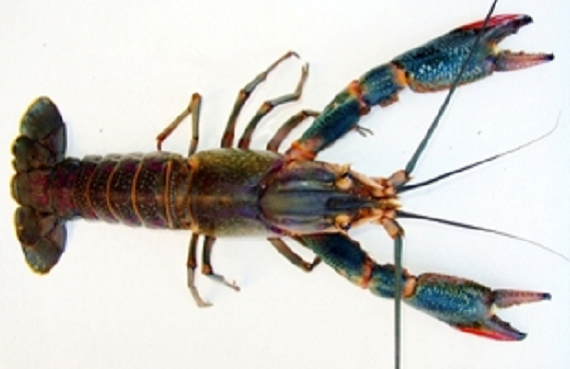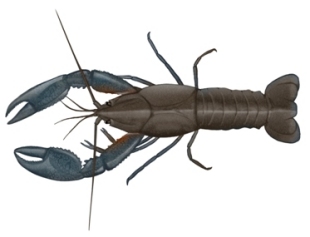Crustaceans
Redclaw crayfish (Cherax quadricarinatus)
Introduction
 Redclaw (Cherax quadricarinatus) is a freshwater crayfish native to parts of northern Australia and Papua New Guinea. Redclaw are tolerant of a broad range of environmental conditions, have a simple reproductive cycle and fast growth rates which has generated interest in the species for commercial aquaculture and ornamental aquarium use. In Australia, redclaw aquaculture operations exist in Queensland, Northern Territory and New South Wales.
Redclaw (Cherax quadricarinatus) is a freshwater crayfish native to parts of northern Australia and Papua New Guinea. Redclaw are tolerant of a broad range of environmental conditions, have a simple reproductive cycle and fast growth rates which has generated interest in the species for commercial aquaculture and ornamental aquarium use. In Australia, redclaw aquaculture operations exist in Queensland, Northern Territory and New South Wales.
The redclaw crayfish has established populations outside of its natural range in six of seven Australian states with Tasmania being the exception. Internationally, introduced populations of redclaw crayfish are known to have established in South Africa, Mexico, Jamaica, Puerto Rico and Singapore.
Redclaw have the potential to impact aquatic ecosystems through modification of natural habitats, direct predation, competition with native species and the introduction of crayfish diseases (Ahyong and Yeo, 2007). Like many freshwater pest fish, once populations of redclaw have become established, eradication is almost impossible. As with all non-natives, this fact highlights the importance of preventing non-native species like redclaw from entering or spreading further in our waterways!
Natural distribution & biology
The name ‘redclaw’ comes from the fact that mature male specimens display distinctive red patches on the claws. The male is larger than the female reaching a maximum of 25 cm in length and weight up to 600g. In their native range, redclaw inhabit a diversity of freshwater habitats including still ponds, small creeks, isolated rock pools and fast flowing rivers. Although native to tropical and subtropical bioregions, they can tolerate a broad temperature range, low dissolved oxygen concentrations and crowded conditions. Redclaw are omnivorous with a diet that includes small invertebrates and aquatic plants. In their natural habitat, redclaw are a relatively non-aggressive, non-burrowing species. However, observation of introduced populations and within the aquarium trade, indicate that this species can display aggressiveness and burrowing habits (Coughran and Leckie, 2007).
Where are they in NSW?
Populations of redclaw in NSW were discovered in Emigrant Creek Dam in 2004 (Coughran and Leckie 2007) and Lake Ainsworth in 2011 (James Melville, pers. comm.). Other anecdotal reports have been recorded, but not confirmed, in the northern rivers region of NSW.
DPIRD issues aquaculture permits that allow the culture of redclaw crayfish as a permissible species. There are currently 9 approved aquaculture facilities in NSW that culture redclaw crayfish. These facilities are located in the council areas of Richmond Valley, Clarence Valley, Kempsy Shire, Port Macquarie-Hastings and Camden.
How did they get here?
There are a number of possible vectors through which redclaw may have been introduced to catchments in NSW including the stocking of farm dams, either intentionally or via contaminated shipments of fish, escape from aquaculture facilities licenced to farm redclaw, or translocation by recreational fishers for use as live bait. Redclaw have also been traded in the ornamental fish industry. As such, the release of unwanted aquarium specimens is another way that this species may have been introduced into the wild in NSW.
Similar native species
 Cherax destructor, or the Yabby, is a widely distributed endemic crayfish in NSW. Yabbies differ from redclaw crayfish in the number of ridges present on the top of their heads. Care should be taken to properly identify specimens to avoid confusion between endemic and introduced species before reporting a suspected sighting of redclaw to DPIRD. Cherax destructor, or the common native yabby, have two raised longitudinal ridges on top of their heads. In contrast, Cherax quadricarinatus, or Redclaw crayfish, have four raised longitudinal ridges on top of their heads.
Cherax destructor, or the Yabby, is a widely distributed endemic crayfish in NSW. Yabbies differ from redclaw crayfish in the number of ridges present on the top of their heads. Care should be taken to properly identify specimens to avoid confusion between endemic and introduced species before reporting a suspected sighting of redclaw to DPIRD. Cherax destructor, or the common native yabby, have two raised longitudinal ridges on top of their heads. In contrast, Cherax quadricarinatus, or Redclaw crayfish, have four raised longitudinal ridges on top of their heads.
What is NSW DPIRD doing?
We support and promote sustainable aquaculture using best practice guidelines such as appropriate screening of ponds and drains to prevent escape of cultured species into the environment. As with other pest species, we recommend recreational anglers humanely euthanase and utilise captured redclaw rather than returning them live to the water. We conduct ongoing monitoring of fish populations in coastal and inland rivers of NSW. If any new populations of redclaw are discovered they will be recorded and monitored.
How can you help?
- Be on the lookout for new species in your local waterways.
- If you find any fish that you think might be a species not native to the area, take a photo, freeze the fish whole and report it!
- Give unwanted aquarium fish to friends or a pet shop, rather than letting them go in the wild (Note: it is illegal to release live fish into NSW waterways without a permit, and heavy penalties apply).
- If you are involved in fish stocking in public waterways, you will need to obtain a fish stocking permit from DPI before buying fish for restocking.
- If looking to stock farm dams, buy fingerlings from local suppliers rather than outside your region. This will minimise the chances of introducing new species to your area.
- If you are a fish farmer, comply with aquaculture permit conditions designed to prevent the escape of fish (e.g. screened water outlets), and keep to the prescribed species list.
References
- COUGHRAN, J. & S. LECKIE, 2007. Invasion of a New South Wales stream by the Tropical Crayfish, Cherax quadricarinatus (von Martens). In: D. LUNNEY, P. EBY, P. HUTCHINGS & S. BURGIN (eds.), Pest or guest: the zoology of overabundance: 40-46. (Royal Zoological Society of New South Wales, Mosman, NSW, ISBN: 978-0-9803272-1-2).
- Ahyong, S. T. & Yeo, D.C.J, 2007. Feral populations of the Australian Red-Claw crayfish (Cherax quadricarinatus von Martens) in water supply catchments of Singapore. Biological Invasions No. 9 pp 943-946.